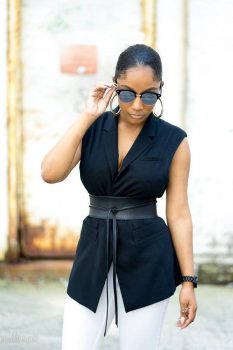I have spent weeks considering the content of this article; reading numerous articles that were scathingly critical of the archaic way the image of the public has been managed over the past few years. One of my favourites was by writer Akola Thompson, she says, “In a country with only two weather patterns, one would expect our clothes to suit them, but instead we have a stringent dress code, which takes none of this into consideration. Before I go on, I believe I should make the point that I believe that rules and codes are necessary. However, if these rules serve no discernible purpose other than to please a society, which is slowly outgrowing the archaic ideology they were founded upon, then maybe these rules or codes need to be revisited.”

When I started working again in Guyana last year, the biggest re-adjustment I had to make was dressing work-appropriately for this heat. Working at a factory I am held to little standard of dressing, other than a minimum of decency and the ability to move around freely. I have days outside the factory that require me being either business formal or business casual, and I quickly adopted armless dresses and sleeveless blazers. The sleeveless blazer was a cool business casual concept that I tried to sell to numerous women here, but they refused to buy into it because in 2017 a vast majority of employers don’t allow women to bare their arms.
The sleeveless blazer
 Is it far-fetched to consider these codes as opportunities to control how women appear in public? It is widely understood that we live in a patriarchal society, last week alone three strangers addressed me as Mr. Brooke Glasford via e-mail. But anecdotes aside, there are a finite number of hours to achieve the goals of your business each day, how many of those hours are you willing to spend policing your employees outfits?
Is it far-fetched to consider these codes as opportunities to control how women appear in public? It is widely understood that we live in a patriarchal society, last week alone three strangers addressed me as Mr. Brooke Glasford via e-mail. But anecdotes aside, there are a finite number of hours to achieve the goals of your business each day, how many of those hours are you willing to spend policing your employees outfits?

Last July, dressed in a sleeveless sheath from her very vast collection of the style, First Lady Sandra Granger took a stand against these dress codes that still plagued many of Georgetown’s establishments, both public and private. Her argument was that there are no actual laws presiding over the issue and that the change could be as simple as taking down the signs. She says, “When you want to invoke something like sleeves, it makes no sense in a tropical country. It makes absolutely no sense and it does not raise my level of decency over somebody else’s by wearing sleeves.” How do we now address the mental conditioning of years past, to get people to understand the length of a sleeve, dress, or skirt has nothing to do with a person’s ability to complete task or any effect of the quality of work produced.
First Lady Sandra Granger (Image via google.com)
On the heels of the First Lady’s comments, the Guyana Revenue Authority (GRA) lifted their dress code to the public in July 2016. The Chairman of their board told this to Stabroek News, “We don’t want the taxpayers to feel as if we are turning our backs on them… and more so if they are coming to pay their revenues.” This is both pragmatic and succinct. I remember very vividly a trip to the GRA last July just after the lift on the dress code; a young lady who was visiting from the US was walking into the building in a camisole and a pair of short shorts. In that moment I thought to myself, “why would you go into a government building dressed that way?” To this day I’m not sure if that thought came from honest critique or conditioning. What she was wearing really affected no one and had no bearing on the transaction she was going to conduct.
With my background in fashion, I definitely see a need for a level of respect to be upheld when entering somewhere to conduct business. An organization trying to maintain a minimum sense of decency on their premises is not too much to ask. However, instead of dictating to the public what not to wear, perhaps it would be more effective to inform them on what would be more appropriate for different aspects of their life.
In, on average, thirty degree Celsius weather, should we really consider styles that we are now programmed to believe acceptable or do we adopt style that will help us survive the day without fainting from dehydration?
As always I’d love to continue this conversation on buildingbrooke.com. What are your thoughts on the topic, are these dress codes principle or just a pain?




